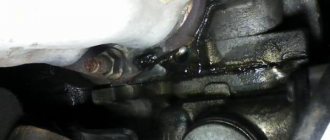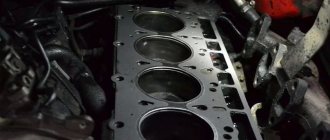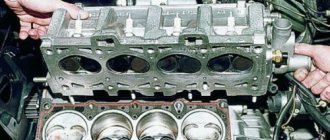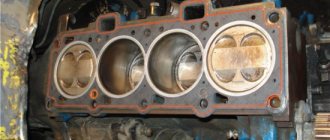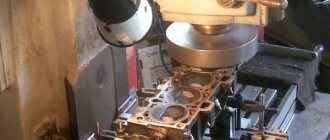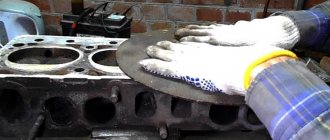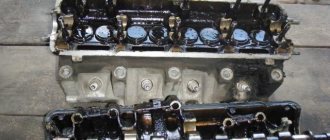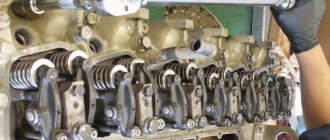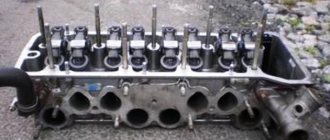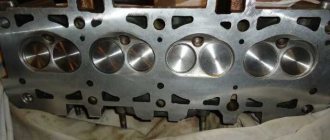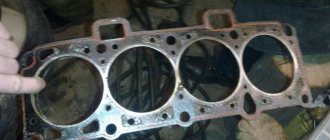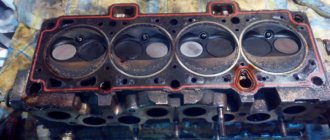How many kg of aluminum are in the VAZ 2106 engine?
How we are working
| VAZ model | Car weight | Blockage |
| 2105 | 955 kg | 30% |
| 2106 | 1045 kg | 30% |
| 2107 | 1060 kg | 30% |
| 2109 | 945 kg | 30% |
Interesting materials:
What is the difference between cabbage soup and green borscht? How to remove hair dye from a case? How to remove soap stains on glass? How to clean the outside of a stainless steel kettle? How to clean the floor from silicone? How to clean silicone from the toilet? How to remove sticker marks? How to clean the inside of a thermos from tea? How to remove iodine from clothes? How to remove red wine from white jeans?
Typical faults and features
If you know the features of the motor used in your personal car, you can significantly extend its service life and maintain good performance. Therefore, we will consider the most typical aspects that relate to this unit.
Warming up . In winter, the engine needs to be warmed up. You need to wait at least five minutes until the speed increases to 1500 rpm. Once the idle starts to hold up well, you can hit the road.
Oil . As for oil, problems often arise due to excessive savings. Owners of the “six” often buy low-quality oil or do not replace it in a timely manner. This leads to the fact that after a mileage of 60 thousand kilometers, the cylinders may increase in diameter. Also, sometimes situations arise that the engine begins to consume too much oil - more than 1 liter for every thousand kilometers. This indicates that it is time to measure the compression. This will let you know if there is a problem with the rings or valves.
Engine tuning
Since the engine has no modifications, the main tuning is to improve the existing characteristics. The main operations are:
- installation of a 16 valve head - allows you to increase power by 17 - 21%;
- modernization of the crankshaft - lightening the connecting rods, crankshaft and pistons, grinding the manifold;
With a minimum budget, tuning usually consists of upgrading the carburetor:
- primary chamber - dismantling the spring to increase the sensitivity of the unit;
- secondary chamber - the vacuum structure is converted into a mechanical one with a piece of wire.
It is important not to forget which oil is recommended by the manufacturer and the timing for replacing consumables.
Thus, the 2106 engine belongs to the “millionaire” category, taking into account the maintainability of the cylinders and piston group, the crankshaft, the interchangeability of crankshafts and camshafts of the VAZ engine family.
Related posts:
- How does a fuel vapor absorber work?
- Nokian tire marking decoding
- Speed characteristics of the VAZ 2106 engine
- Do-it-yourself noise insulation of car fender liner video
| 1) adjusting the ignition, checking the oil level, replacing bearings, tightening the flywheel bolts | |
| Low oil pressure on a warm engine | 1) wear of oil pump gears |
| 1) unit repair | |
| Increased lubricant consumption | 1) leaking seals |
| 1) replacement of consumables | |
| Increased gas mileage | 1) the damper opening angle is off |
| 1) damper adjustment | |
| Reduced throttle response and power | 1) pump failure |
| 1) pump repair |
Injection modification
The first in the line of internal combustion engines of the AvtoVAZ manufacturer, the 2106 engine received tuning in the form of distributed injection. At the same time, the owners received a headache:
- intense heating, since the mixture is lean, the manufacturer’s cooling system cannot cope with temperature loads;
- increased fuel consumption up to 13 l/100 km in winter.
A positive feature is the low budget for major repairs within 10,000 rubles.
Technical characteristics of the motor 2106
After a failure with the timing belt in the internal combustion engine 2105, the manufacturer AvtoVAZ returned to the chain drive.
The standard for the 2106 engine was version 2103; the cylinder diameter was increased to the original 79 mm, as in modification 21011. Therefore, the technical characteristics of the internal combustion engine are as follows:
| Manufacturer | VAZ |
| Engine brand | VAZ-2106 |
| Years of production | 1976 — 2006 |
| Volume | 1569 cm 3 (1.5 l) |
| Power | 64-75 hp |
| Torque | 87.3 Nm (3400 rpm) |
| Weight | 121 kg |
| Compression ratio | 8,5 |
| Nutrition | carburetor Solex 1107010-01, then 1107010, since 1980 Ozone 1107010-20 |
| Motor type | in-line |
| Number of cylinders | 4 |
| Location of the first cylinder | near the timing chain |
| Number of valves on each cylinder | 2 |
| Cylinder head material | aluminum alloy |
| Allowable warpage | manifold gaskets (intake/exhaust) 0.08 mm |
cylinder head gasket 0.05 mm
class B - 79.01 - 79.02 mm
class C - 79.02 - 79.03 mm
class D - 79.03 - 79.04 mm
class E - 79.04 - 79.05 mm
cast iron rings, compression outside chrome plated (top) and bevelled (bottom)
class C - 78.96 - 78.97 mm
class E - 78.98 - 78.99 mm
piston rings - 110 mm relative to the cut plane
VAZ engine malfunctions and their symptoms
No matter how reliable the power unit of the “penny” is, it can also sometimes be capricious. The main signs of its malfunction are:
- inability to start;
- unstable operation at idle, tripping;
- reduction in traction and power characteristics;
- overheat;
- extraneous noise (knocking, clattering);
- the appearance of white (blue) exhaust.
Naturally, any of the listed symptoms cannot clearly indicate a specific malfunction, so let's look at them in more detail in the context of possible breakdowns.
The engine won't start at all
If, when you turn on the ignition and turn the key to the position at which the starter is turned on, the latter works, and the power unit shows no signs of life at all, this may be evidence of failure:
- ignition coils;
- distributor;
- breaker;
- ignition circuits;
- fuel pump;
- carburetor
If such a symptom is detected, you should not immediately change any of the ignition system components or disassemble the carburetor. First, make sure that voltage from the battery is supplied to the coil, distributor, distributor, and spark plugs. After this, you can begin diagnosing the fuel pump and carburetor.
Unstable operation at idle
In this case, the malfunction can also be caused by problems in two systems: power and ignition. Typical breakdowns accompanied by this symptom include:
- failure of the carburetor solenoid valve;
- clogging of the fuel filter at the inlet to the carburetor;
- clogged fuel or air jets;
- violation of regulation of the quality and quantity of the fuel-air mixture;
- malfunction of one or more spark plugs;
- burning of the contacts of the ignition distributor, distributor cap, slider;
- breakage of the current-carrying core (insulation breakdown) of one or more high-voltage wires.
Here, as in the previous case, it is better to start searching for the problem by checking the ignition system.
Reduced engine power
The power unit may lose its power characteristics due to:
- fuel pump malfunction;
- clogged fuel filter or fuel line;
- violation of regulation of the quality of the fuel-air mixture;
- increasing the gap between the breaker contacts;
- incorrect adjustment of valve timing or ignition timing;
- wear of piston group elements.
If you detect a decrease in the power and traction characteristics of the power unit, first check whether the timing marks of the gas distribution mechanism match, and also whether the ignition timing is set correctly. Next, you should make sure that the gap between the distributor contacts is adjusted correctly. After this, you can start checking the fuel pump, filter and carburetor. If a drop in engine power is accompanied by thick white smoke from the exhaust pipe, the appearance of an oil emulsion in the air filter housing is a clear sign of wear or damage to the piston parts.
Overheat
A violation of the normal temperature regime can be identified by observing the behavior of the arrow on the temperature indicator located on the vehicle’s instrument panel. When overheated, it moves to the red sector of the scale. In more complex cases, the coolant simply boils. Under no circumstances should you continue driving with such a malfunction. This will inevitably lead, at a minimum, to burnout of the cylinder head gasket.
Engine overheating can be caused by:
- thermostat malfunction (blocking the movement of fluid through the cooling radiator);
- breakdown of the water pump (pump);
- low level of coolant in the system (depressurization, leakage of coolant);
- inefficient operation of the radiator (clogged tubes, external lamellas);
- broken radiator fan drive belt.
Having discovered that the car’s engine has begun to overheat, the first thing you need to do is check the coolant level in the expansion tank. Next, you need to determine whether the thermostat opens to a large circle. To do this, just touch the radiator pipes. With a warm engine they should both be hot. If the top one is hot and the bottom one is cold, the thermostat is faulty and needs to be replaced.
It is almost impossible to determine if the pump is faulty without dismantling it, so it is better to leave this option for last. But the performance of the fan is easy to determine. The “penny” has a permanent drive. Its impeller is driven by a V-belt from the crankshaft pulley. By the way, this belt also ensures the operation of the water pump, so if it breaks, two components of the cooling system will fail at once.
Extraneous noise in the engine
A car engine itself is a rather complex mechanism that produces many different sounds during operation. It is impossible for an uninitiated person to determine by ear a malfunction of the power unit, but a specialist, even without additional equipment, can tell you which sound is unnecessary and what kind of breakdown it indicates. For the VAZ 2101, the following extraneous sounds can be distinguished:
- valve knocking;
- knocking of main or connecting rod bearings;
- clatter of piston pins;
- loud rustling of the timing chain.
Valve knocking can occur due to increased clearance in the valve mechanism, wear of the valve springs, and wear of the camshaft cams. A similar problem is solved by adjusting the valves, replacing springs, restoring or replacing the camshaft.
The crankshaft main and connecting rod bearings may also make knocking noises. Such a malfunction may indicate low oil pressure in the system, increased clearance between the bearings and connecting rod journals, or severe wear of the bearings themselves.
Piston pins usually knock for one reason - incorrectly set ignition angle. Their knocking indicates that the fuel-air mixture ignites too early, which causes detonation in the combustion chambers. It is enough to “delay” the ignition a little by turning the distributor clockwise, and the problem will disappear.
The timing chain cannot help but rustle while driving, but an excessively loud sound is a sign of either stretching or a broken damper. Such a breakdown can be eliminated by replacing the damper or tensioner shoe.
Thick white exhaust
A serviceable engine practically does not smoke in dry weather. In frost or rain, the exhaust becomes noticeably denser due to condensation. This is absolutely normal. But if thick white (in some cases bluish) smoke comes from the exhaust pipe, regardless of weather conditions, most likely there is wear on the piston rings, and perhaps on the pistons themselves and the cylinder walls. In this case, the oil enters the cylinders and burns, and the oil that does not burn is expelled through the carburetor into the air filter housing. It is the burnt grease that creates that white smoke. In addition, when parts of the piston group wear out, exhaust gases can enter the lubrication system, creating excess pressure there. As a result, oil may even leak out through the dipstick hole. There is only one way out - a major overhaul of the engine.
But that's not all. White exhaust is also a sign of cylinder head gasket damage, in which coolant circulating in the cooling jacket enters the combustion chambers. This malfunction is almost always accompanied by exhaust gases entering the expansion tank. So, if you see white smoke, don’t be too lazy to look into the tank. The smell of the exhaust and air bubbles will point you in the right direction to find the problem.
Disadvantages and advantages
The 2106 engine has significant disadvantages:
- excess heat is transferred to the well of the piston bottom and fins by steel control plates inside the bosses;
- dynamic loads are reduced due to the displacement of the finger from the axis of symmetry to the right;
- When assembled into an engine, the pistons are mounted with markings in one direction, which increases labor costs and the human factor.
The internal combustion engine uses a cylinder head from model 2103, a starter 35.3708 and a G221 generator for an engine with a current of 42A. Oil consumption does not exceed 700 g/1000 km. The instruction manual states that it is recommended to add 200 ml less lubricant than the volume of the system as a whole. The markings for which oil to pour are given in the upper table.
In what models was the VAZ used?
Improved engine characteristics made it possible to equip VAZ cars of the following models with it:
- 2103 Zhiguli sedan;
- 21054 Zhiguli sedan (only for the FSB, the Ministry of Internal Affairs and the State Traffic Safety Inspectorate);
- 2106 Lada sedan;
- 21074 Lada sedan;
- 2121 Niva carrying a 5-door station wagon or 3-door hatchback.
Due to the following difficulties in manufacturing some parts, management considered the 2106 motor to be economically unprofitable and it was discontinued.
